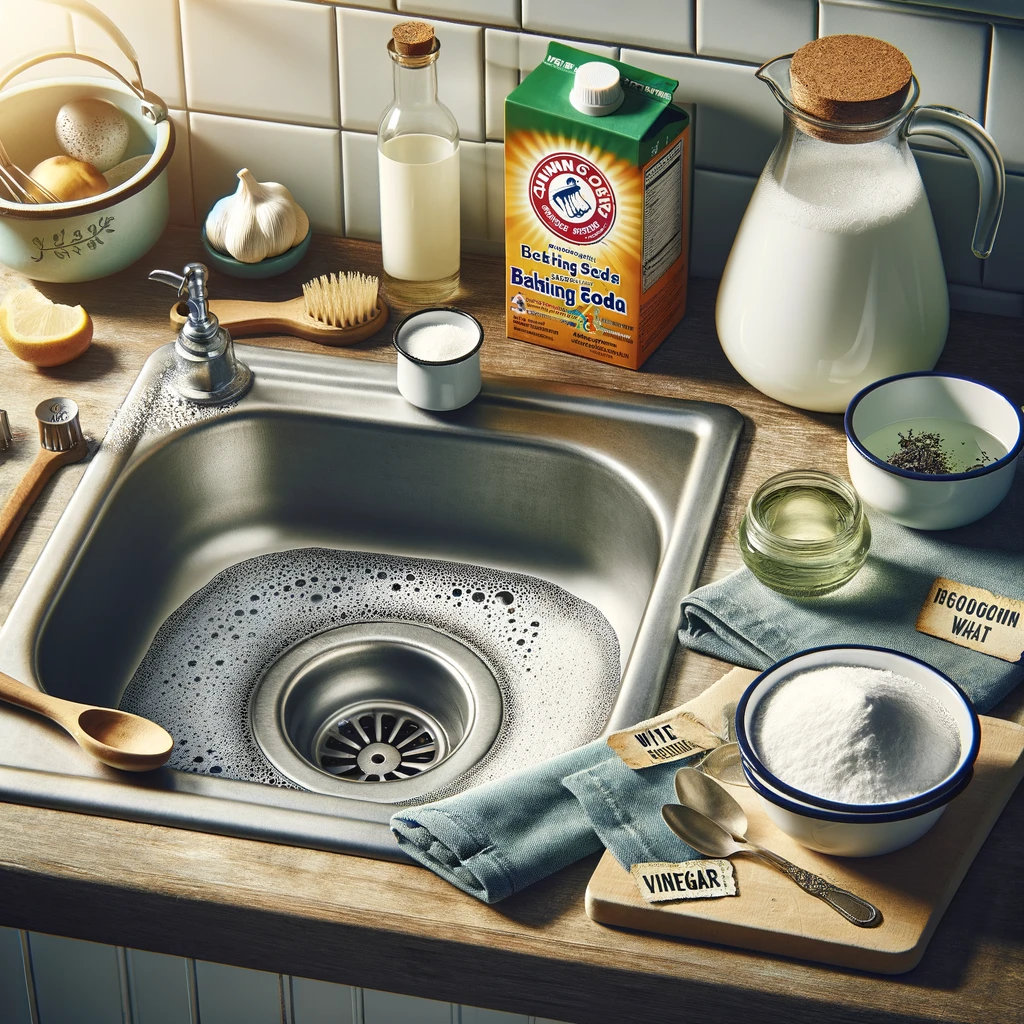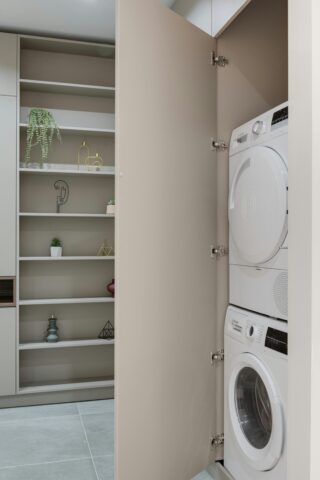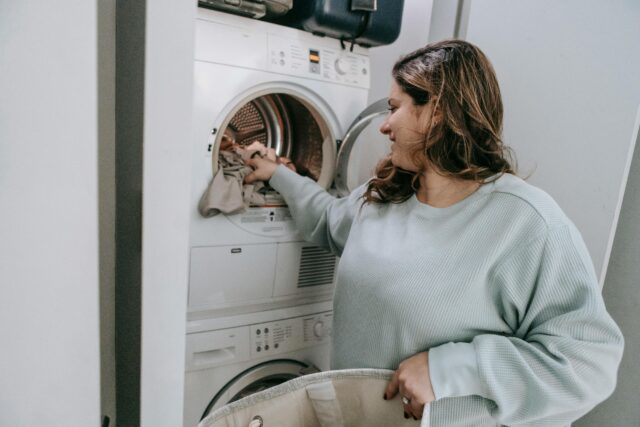What’s up, my organizer fam! Pan here, ready to drop some serious knowledge on how to unclog that kitchen sink without even calling a plumber. You know I’m all about those simple, DIY solutions using stuff you already have at home.
So listen up – I was recently chatting with my plumber buddy L, and he let me in on a little secret. You don’t always need to fork over the big bucks to get your drain flowing freely again. With just a couple household ingredients, you can whip up your own clog-busting potion.
The two magic ingredients? Baking soda and white vinegar – a duo more powerful than any overpriced chemical drain cleaner. I know some of you probably reach for the plunger first when that sink gets backed up. But trust me, while that might provide a temporary fix, it’s not getting to the real root of the problem – all that built-up gunk and grease coating your pipes.
To really blast through that nasty stuff, you need a foaming chemical reaction. That’s where the baking soda and vinegar come in to work their fizzy magic. This method is so easy, you’ll be done in a matter of minutes! And if you like what you see today, don’t forget to subscribe so you can keep getting more of my awesome organizational tips and tricks.
Alright, enough jibber-jabber, let’s get into the unclogging steps! First up, pour a pot of boiling water down that drain to start breaking things up. Then, dump in 1 cup of baking soda and let it go to work for 5-10 minutes. After that, add 1 cup of white vinegar – yeah, it’s gonna get all bubbly and volcano-like, just like those classic science experiments when you were a kid! Let that chemical reaction do its thing for another 5-10 minutes.
Once time’s up, follow it with another pot of boiling water to really power through that clog. Finally, run hot tap water for 5 minutes to flush everything out. That’s literally it! In just a few simple steps using pantry ingredients, you’ll have clear drains again.
If this DIY method works its magic for you, let me know in the comments! I wanna hear all about your clog-busting success stories.
Dealing with Clogged Drains: A Safe and Natural Approach
We’ve all been there – water slowly draining or refusing to go down the sink or tub. Clogged drains are a frustrating household issue that can quickly escalate into a plumbing nightmare if left unaddressed. When faced with a stubborn clog, many of us turn to chemical drain cleaners, lured by their promises of instant unclogging power. However, these harsh chemicals come with a hidden cost – they can corrode your pipes, harm the environment, and even pose health risks to you and your family.
The good news is that there are safe, natural alternatives that can tackle even the toughest clogs without compromising your well-being or the planet. This article will guide you through the world of eco-friendly, DIY drain unclogging methods, so you can bid farewell to toxic chemicals for good.
The Downside of Chemical Drain Cleaners
Chemical drain cleaners may seem like a quick fix, but their negative impacts are far-reaching. These harsh substances contribute significantly to water pollution, harming aquatic life and disrupting delicate ecosystems. Moreover, they can eat away at your pipes, leading to costly repairs or replacements down the line.
Perhaps the most concerning aspect of chemical drain cleaners is the potential health hazards they pose. Exposure to these toxic chemicals can cause respiratory issues, skin irritation, and even more severe health problems, making them a risk not worth taking, especially if you have children or pets in your household.
The Power of Natural Drain Unclogging
Fortunately, there are numerous natural solutions that are gentle on your plumbing and the environment, ensuring a cleaner, healthier home for you and your loved ones. Many of these eco-friendly methods utilize everyday household items, saving you money while getting the job done effectively. No need for special trips to the store – you likely already have the necessary ingredients in your pantry or under your kitchen sink.
DIY Natural Drain Unclogging Methods
- The Baking Soda and Vinegar Miracle: This classic combination is a powerhouse for breaking down clogs. Start by pouring a cup of baking soda down the drain, followed by a cup of vinegar. Let the mixture fizz and work its magic for 15-20 minutes before flushing with hot water.
- Hot Water Flush: Sometimes, a simple burst of hot water is all it takes to dislodge a stubborn clog. Boil a kettle of water and carefully pour it down the drain, being cautious of any splashing.
- Salt, Baking Soda, and Vinegar Trio: For tougher clogs, combine 1/2 cup of salt with 1/2 cup of baking soda and 1 cup of vinegar. Pour the mixture down the drain, allow it to sit for several hours, and then flush with hot water.
- Dish Detergent and Hot Water for Grease Clogs: Grease buildup is no match for this dynamic duo. Pour a generous amount of dish detergent down the drain, followed by a kettle of boiling water. The detergent helps break down and flush away stubborn fats.
- The Trusty Plunger: Don’t underestimate the power of an old-fashioned plunger. Create a tight seal around the drain and plunge vigorously several times to dislodge the clog.
- Enzyme-Based Cleaners for Maintenance: These natural, enzyme-based cleaners help prevent future clogs by breaking down organic matter in your pipes. Look for eco-friendly brands or make your own with natural ingredients like lemon juice and baking soda.
Step-by-Step Guide: Baking Soda and Vinegar Solution
The baking soda and vinegar solution is a tried-and-true method that deserves a closer look. Here’s a step-by-step guide to help you harness the full potential of this powerful, natural unclogging duo:
- Preparing the Powerhouse: Start by pouring 1 cup of baking soda down the drain. Next, add 1 cup of vinegar. The combination of these two ingredients will create a fizzy chemical reaction that helps break down the clog.
- Application Instructions: Let the mixture sit and work its magic for 15-20 minutes. During this time, the fizzing action will help dislodge and dissolve the clog.
- The Final Flush: After the allotted time, carefully pour a kettle of boiling water down the drain. The hot water will help flush away the loosened debris, leaving your drain clear and free-flowing.
Preventing Future Clogs
While these natural methods are effective for clearing existing clogs, prevention is the ultimate key to maintaining clear drains. Simple routines like regular drain cleaning and proper waste disposal can go a long way in preventing clogs from forming in the first place.
When it comes to waste disposal, it’s important to be mindful of what should and shouldn’t go down your drains. Avoid pouring cooking oils, grease, or food scraps down the sink, as these can solidify and create stubborn clogs over time. Additionally, be cautious of hair, soap scum, and other organic matter that can accumulate in your drains.
Incorporating enzyme-based cleaners into your maintenance routine can also help break down organic matter before it becomes a clog. Look for eco-friendly brands or make your own with natural ingredients like lemon juice and baking soda.
By embracing natural, eco-friendly solutions for drain unclogging, you can protect your plumbing, safeguard your health, and do your part for the environment – all while saving money in the process. Say goodbye to harsh chemicals and hello to a safer, greener approach to household maintenance. Your drains – and the planet – will thank you.
Remember, a little prevention goes a long way. Implement regular drain cleaning and waste disposal best practices to keep your drains flowing freely. And when a clog does occur, reach for natural ingredients like baking soda, vinegar, and hot water instead of resorting to toxic chemical cleaners.
Your home deserves a safe and sustainable approach to drain maintenance. Embrace the power of nature, and you’ll never have to worry about clogged drains again.



